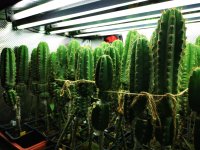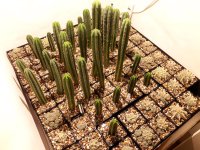Hello,
Allow me to introduce myself, I have a background in microbiology and chemistry and I have been growing and analyzing Trichocereus cacti for over 20 years. Congratulations on your grafting setup, it's very impressive!
I have been reading through this thread from start to finish. There is one significant flaw in your procedure and that is this: There is ZERO correlation between bitter taste and M content in these cacti. A bitter tasting cactus could have none at all and one that is perceived to be tasteless could be potent. This is why my heart sank when you said that you discarded 83% of your samples.
Let me elaborate: The idea that potency can be determined by taste is an urban myth. This would be equivalent to claiming that one could determine the caffeine content of various coffee beans just by licking them. Someone probably read somewhere that alkaloids are bitter and made this false assumption. The reality is much more complex.
Let's start with the m molecule itself. Most people are familiar with this compound as its HCl salt. Hydrochloric acid is an extremely harsh tasting mineral acid and M-HCl does have a bitter taste. But M is not present in the cactus as the HCl salt. In fact it is present as the salt of MALIC acid. Malic acid is an organic acid with a pleasantly sour taste. Malic acid is what makes apples taste tart.
M-malate, the salt form present in the cactus, does not even have a particularly bitter taste. Pure m-malate is rare, and few people have tasted it in its pure form. I have, and the taste is mild and complex with predominantly sour and salty notes. But the important thing to know is that the immediate taste that comes across is not bitterness.
Now let's talk about taste threshold. A strong cactus would be one approaching 1% M content by dry weight. But cactus is 95% water so this equates to only about 0.05% in the fresh cactus. This is below most people's taste threshold, which studies have shown to be about 0.1% for most compounds. By licking the cut end of a cactus, you are only exposing your tongue to a drop of cactus juice and at best it would only contain about 0.03mg of m-salts. In order to taste the m-malate at all, you would probably need at least 1mg of the substance on your tongue, and more than that to get the real character of its flavor.
Then there are the bitter compounds in cactus that will overwhelm the taste buds and mask anything else. There are numerous plant compounds in cactus such as tannins, polyphenols, flavonoids, isoflavones, and glucosinolates that overwhelm the flavor. One of the main ones is cactus slime, or mucilage. Mucilage is composed of pectin, which is very bitter, and is responsible for much of the well-known disgusting taste of cactus brew, along with the aforementioned compounds. With the presence of all these compounds masking the flavor of cactus, there is no way that the minute quantity and subtle taste of m-malate would ever be able to come through.
Finally there are the salts. Cactus contains a number of mineral salts drawn from the earth such as NaCl (table salt) and Calcium Carbonate. Even if we were to filter away all the aforementioned bitter plant compounds what we would be left with would be the m-malate plus the remaining plant salts. The taste of this mixture is dominated by the NaCl and thus the taste is salty, and not bitter.
So you can see that the taste method is completely worthless as an arbiter of potency. I'm sorry I wasn't able to chime in here before you threw out 83% of your samples, many of which no doubt had potential. You will need to find a real, reliable way to determine potency in your remaining samples. Since you don't have access to lab HPLC or GC equipment, the next best thing would be an extraction and purification.
Save for an extraction, the next best thing would be a bioassay, a fancy word for drinking a brew. A good starting point might be 5 grams dried (about 100 grams fresh cactus). I have found that for me 5g is a large enough microdose to elicit a threshold response if the cactus is decently potent.
To make a brew, you just need to dry, pulverize and extract thoroughly with hot distilled water only. You don't need to add lemon or vinegar or anything else, as the M as the malic acid salt is already very water soluble.
Good luck with your endeavor!



